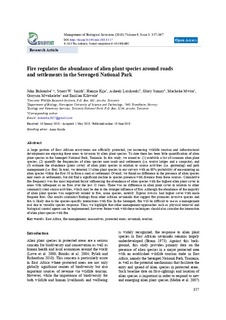| dc.contributor.author | Bukombe, John | |
| dc.contributor.author | Smith, Stuart | |
| dc.contributor.author | Kija, Hamza | |
| dc.contributor.author | Loishooki, Asheeli | |
| dc.contributor.author | Sumay, Glory | |
| dc.contributor.author | Mwita, Machoke | |
| dc.contributor.author | Mwakalebe, Grayson | |
| dc.contributor.author | Kihwele, Emilian | |
| dc.date.accessioned | 2019-04-05T11:31:59Z | |
| dc.date.available | 2019-04-05T11:31:59Z | |
| dc.date.created | 2018-09-17T12:55:03Z | |
| dc.date.issued | 2018 | |
| dc.identifier.citation | Management of Biological Invasions. 2018, 9 (3), 357-367. | nb_NO |
| dc.identifier.issn | 1989-8649 | |
| dc.identifier.uri | http://hdl.handle.net/11250/2593517 | |
| dc.description.abstract | A large portion of East African ecosystems are officially protected, yet increasing wildlife tourism and infrastructural development are exposing these areas to invasion by alien plant species. To date there has been little quantification of alien plant species in the Serengeti National Park, Tanzania. In this study, we aimed to: (1) establish a list of common alien plant species; (2) quantify the frequencies of alien species near roads and settlements (i.e. tourist lodges and a campsite), and (3) estimate the abundance (plant cover) of alien plant species in relation to source activities (i.e. gardening) and park management (i.e. fire). In total, we detected 15 alien plant species in our surveys with an 80% probability of encountering an alien species within the first 50 m from a road or settlement. Overall, we found no difference in the presence of alien species near roads or settlements, but did find a significant decline in species presence with distance from these sources. Cumulative fire frequency was the most important factor influencing the abundance of alien species with the highest alien plant cover in areas with infrequent or no fires over the last 13 years. There was no difference in alien plant cover in relation to other commonly cited source activities, which may be due to the stronger influence of fire. Although the abundance of the majority of alien plant species was negatively related to fire, some species, notably Tagetes minuta, had higher cover with more frequent fires. Our results contradict findings from other African savannahs that suggest fire promotes invasive species and this is likely due to the species-specific interactions with fire. In the Serengeti, fire will be difficult to use as a management tool due to variable species response. Thus, we highlight that other management approaches such as physical removal and biological control agents can be implemented; however future work with these techniques should also consider the interaction of alien plant species with fire. | nb_NO |
| dc.language.iso | eng | nb_NO |
| dc.publisher | Regional Euro-Asian Biological Invasions Centre (REABIC) | nb_NO |
| dc.rights | Navngivelse 4.0 Internasjonal | * |
| dc.rights.uri | http://creativecommons.org/licenses/by/4.0/deed.no | * |
| dc.title | Fire regulates the abundance of alien plant species around roads and settlements in the Serengeti National Park | nb_NO |
| dc.type | Journal article | nb_NO |
| dc.type | Peer reviewed | nb_NO |
| dc.description.version | publishedVersion | nb_NO |
| dc.source.pagenumber | 357-367 | nb_NO |
| dc.source.volume | 9 | nb_NO |
| dc.source.journal | Management of Biological Invasions | nb_NO |
| dc.source.issue | 3 | nb_NO |
| dc.identifier.doi | 10.3391/mbi.2018.9.3.17 | |
| dc.identifier.cristin | 1610137 | |
| dc.description.localcode | Under the Creative Commons Attribution License (Attribution 4.0 International - CC BY 4.0) | nb_NO |
| cristin.unitcode | 194,66,10,0 | |
| cristin.unitname | Institutt for biologi | |
| cristin.ispublished | true | |
| cristin.fulltext | original | |
| cristin.qualitycode | 1 | |

